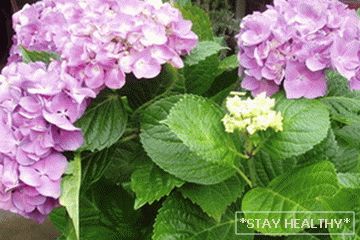 Sat, 05 Mar 2016
Sat, 05 Mar 2016
Род Гортензия (Hydrangea) семейства
Hortensia is represented by about 90 plant species. He happens
from Asia, America and Japan, where it will grow in nature today, and in
This flower is spread throughout the world. It is used
as a decorative leafy, and flowering
plants, and grown in terms of apartments, greenhouses and
gardens.
Hydrangea is a very beautiful wintering shrub,
reaching a height of 2 m, decorated in the period of flowering large (up to
30-40 cm long), pyramidal, abundantly covering it
inflorescences with yellowish-white flowers, slightly reddening
afterwards. One bush can carry up to 100 or more inflorescences.
According to one version, the name of this plant was given
French physician and naturalist Philibert Commerson, who
XVIII century during his trip to Japan, seeing magnificently
flowering shrubs, began to ask about it the locals.
When none of them could say his name, the doctor gave him a name.
in honor of his beloved Hortense.
In our ornamental gardening use several types
of this beautiful plant: tree hydrangea (Hydrangea
arborescens), paniculate hydrangea, stalked hydrangea,
Bretshneider hydrangea (H. bretschneideri), as well as large-leaved,
or garden, hydrangea (H. macrophylla). Planted hydrangeas
singly or in groups on the lawn. For any garden plot, park
and square they will be a real decoration.
Contents
Hydrangea – growing and care
For hydrangeas, choose well-lit areas with
loose, rich in organic matter, moderately moist soils that have
neutral or slightly acidic. For hydrangea tree
poor soil may be suitable, although its flowering will be
less intense. It is also the most drought resistant of
of all kinds, while the hydrangea paniculata is more moisture-loving,
and for hydrangea, large-leaved dryness is fraught with death.
To improve root aeration, it is necessary to loosen several times a year.
the soil surface around the bushes to a depth of 5 cm. Since
hydrangea is a very moisture-loving plant, it follows
water every week, tree trunks need to be mulched
peat or sawdust, which layer should be about 6
cm.
Very important for hydrangeas correct pruning. Do it should
in early spring, until the active growing season. Old inflorescences
should be removed before the first pair of strong and healthy kidneys. Helpful
also annually do adult root pruning
several old, weak or too densely located
branches.
Гортензия – пересадка и breeding
When transplanting plants they are placed at a distance of from 1 to 1.5 m
from each other, pitting depths up to 60 cm and adding to them
fertilizers, such as organic, urea, granular
superphosphate, potassium sulfate. After such planting plant 2 years
no need to feed. Then you need to spend up to several
top dressing per year: the first comes in the spring, the period of the beginning of growth,
the second – in the period of the appearance of the buds, the third and fourth dressing
spend the summer.
Propagated by hydrangea division of the bush, layering and cuttings. For
cuttings take woody and green cuttings that can
to propagate in the winter. For этого их нарезают с осени и хранят в
the refrigerator in plastic bags filled with wet sand.
In February, they are planted in pots with a soil mixture from
turfy ground, peat and washed river sand. Should also
take care of good drainage.
Before planting in the pot the lower part of the cutting is needed
Pre-dip 1% powdered heteroauxin with talc.
After watering the cuttings should be covered with plastic wrap and
keep in a bright place at a temperature of 20 ° C to 22 ° C. About
after a month should appear green shoots that should be in
end of April to land in greenhouses with shading. When cuttings
root well, at the end of the summer they are planted on a permanent
a place.
Hydrangea – diseases and pests
Under the conditions of care, hydrangea rarely gets sick, and yet
She is subject to some diseases. For example, if on the leaves
yellow mosaic spots or streaks appeared, meaning plant
a viral disease like leaf mosaic disease has caught up.
In this case, the affected shoots are cut and burned, and when
the strong spread of the disease destroys the whole plant.
Lightening leaves says chlorosis. It may occur due to
excess lime or humus in the soil. To return
the plant has a decorative appearance, it needs to be watered several times
potassium nitrate (taken 20 g per 5 l of water), and after three days
irrigate using a solution of ferrous sulfate in
the same concentration.
If oily yellowing spots appear on the leaves, which
gradually darken and increase in size, as well as yellowish
plaque in their lower part, which means that the plant is affected by a downy powdery
dew. It may develop due to high air humidity. To
save the plant, it needs to be treated with a copper liquid,
which is made from 150 grams of green soap and 15 grams of copper sulfate,
taken on 10 liters of water.
Hydrangea can also be affected by pests: spider mites or
green leaf aphids. In the first case, the plant should be sprayed.
a solution of thiophos, prepared from 5-7 g of the substance to 10 liters of water. WITH
aphids fight by spraying a plant twice
anabazine sulfate. To приготовить раствор, берется 15— 20 г
Anabazin sulfate per 10 liters of water. This remedy is the most
radical and effective in dealing with leaf aphids.





